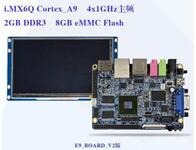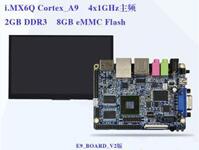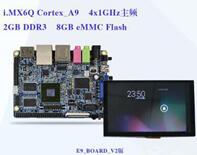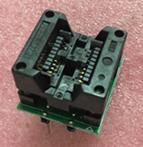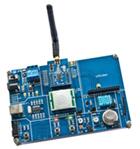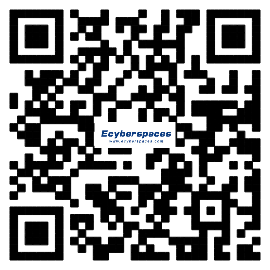Processor Parameters
•Core: ARM 32-bit Cortex™-M4 CPU with FPU, Adaptive real-time accelerator (ART Accelerator™) allowing 0
-wait state execution from Flash memory, frequency up to 168 MHz, memory protection unit, 210 DMIPS/1.25
DMIPS/MHz (Dhrystone 2.1), and DSP instructions
•Memories
•Up to 1 Mbyte of Flash memory
•Up to 192+4 Kbytes of SRAM including 64-Kbyte of CCM (core coupled memory) data RAM
•Flexible static memory controller supporting Compact Flash, SRAM, PSRAM, NOR and NAND memories
•LCD parallel interface, 8080/6800 modes
•Clock, reset and supply management
•1.8 V to 3.6 V application supply and I/Os
•POR, PDR, PVD and BOR
•4-to-26 MHz crystal oscillator
•Internal 16 MHz factory-trimmed RC (1% accuracy)
•32 kHz oscillator for RTC with calibration
•Internal 32 kHz RC with calibration
•Sleep, Stop and Standby modes
•VBATsupply for RTC, 20×32 bit backup registers + optional 4 KB backup SRAM
•3×12-bit, 2.4 MSPS A/D converters: up to 24 channels and 7.2 MSPS in triple interleaved mode
•2×12-bit D/A converters
•General-purpose DMA: 16-stream DMA controller with FIFOs and burst support
•Up to 17 timers: up to twelve 16-bit and two 32-bit timers up to 168 MHz, each with up to 4 IC/OC/PWM or pulse counter and quadrature (incremental) encoder input
•Debug mode
•Serial wire debug (SWD) & JTAG interfaces
•Cortex-M4 Embedded Trace Macrocell™
•Up to 140 I/O ports with interrupt capability
•Up to 136 fast I/Os up to 84 MHz
•Up to 138 5 V-tolerant I/Os
•Up to 15 communication interfaces
•Up to 3 × I2C interfaces (SMBus/PMBus)
•Up to 4 USARTs/2 UARTs (10.5 Mbit/s, ISO 7816 interface, LIN, IrDA, modem control)
•Up to 3 SPIs (37.5 Mbits/s), 2 with muxed full-duplex I2S to achieve audio class accuracy via internal audio PLL or external clock
•2 × CAN interfaces (2.0B Active)
•SDIO interface
•Advanced connectivity•USB 2.0 full-speed device/host/OTG controller with on-chip PHY
•USB 2.0 high-speed/full-speed device/host/OTG controller with dedicated DMA, on-chip full-speed PHY and ULPI
•10/100 Ethernet MAC with dedicated DMA: supports IEEE 1588v2 hardware, MII/RMII
•8- to 14-bit parallel camera interface up to 54 Mbytes/s
•True random number generator
•CRC calculation unit
•96-bit unique ID
•RTC: subsecond accuracy, hardware calendar
Development board hardware configuration
1) 16M Bit high speed asynchronous CMOS static RAM
2) 4G Bit NAND Flash
3) IIC EEPROM
4) 20 pin 2.54 spacing JTAG interface
5) 10/100M Ethernet interface (MII, RMII two kinds of configuration mode)
6) USB2.0 high speed master-slave device interface (mini)
7) High speed USB2.0 host device interface
8) USB2.0 full master-slave device interface (mini)
9) USB2.0 full master interface
10) 2 road RS232 interfaces
11) 2 road CAN2.0 interfaces
12) SD memory card interface (4-bit)
13) Audio output and microphone input interface
14) LCD interface 16 bit bus mode
15) A controlled LED
16) Three buttons with a wake-up function
17) An adjustable resistor
18) Big button battery seat (because of the air embargo, default unworthy of button batteries)
19) 2.54mm core board spacing I/O outlet, can be installed in the universal board
Function description
1 With the HTTP Webpage server function, can the image through Webpage way to view camera, network camera functions
2 Full speed USB interface can read U disk, high speed USB interface connected to host computer and 3.2 inch touch screen together to achieve the function of touchpad
3 Audio can play stored in SD card WAV format audio files, (plus a recording module) can be recorded voice file to SD card
4 Images can be collected by camera compressed to save JPEG or BMP format file to SD card
5 browse the image file stored in the SD card
Example Program Characteristics
1 Operating system
RTX--V4.20 (Keil operating system)
FreeRTOS--V7.1.1
C/OS-II--V2.86
RT-Thread - V1.1.0
2 File system
RL-FlashFS--V4.22 (Keil file system, support FAT12, FAT16 and FAT32 file system, the file system can be used in the SD card, Nand Flash, U disk, provide bad block management function of Nand Flash)
FatFs--R0.08a
3 Network protocol stack
RL-TCPnet--V4.23 (Keil network protocol stack)
Lwip--V1.3.2
4 Graphics Library
The new version of C/GUI emWin--V5.12
STM32 Embedded GUI Library--V2.1.0; ST release of the embedded GUI graphics library
C/GUI—emWin (old version) with source code
5 JPEG codec: Libjpeg--v8d
6 USB
RL-USB--V4.22; Keil comes with the USB protocol stack, support ADC, CDC, HID, MSC class from the equipment, the main controller supporting HID and MSC
USB-Host-Device Lib-- V2.1.0; ST USB protocol stack, support ADC, CDC, HID, MSC, DFU class from the equipment, the main controller supporting HID and MSC
Note
STM32F407IG processor without LCD controller, only control the CPU interface LCD screen. If want to control the RGB interface of the 4.3 inch or 7 inch LCD screen, it need to add another LCD screen control chip, usually can use SSD1963 (16-23RMB) to do the LCD controller
Shipping List
1* STM32F407IGT6 core board
1* STM32F407IGT6 development plate
1* 3.2 inch touch screen module
1* 130W pixel camera module
1* crossover cable
1* Serial port extension line
1* High speed Mini USB line
1* High quality 5V power adapter








 Development Kit
Development Kit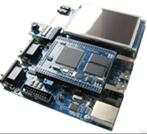
 Mouse over to zoom in
Mouse over to zoom in


